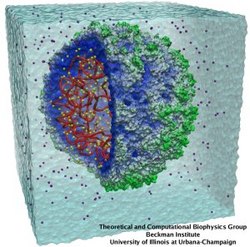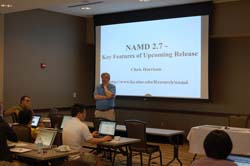Free Software is the Right Prescription for Biomedical Science
The Visual Molecular Dynamics (VMD) program uses 3D graphics to animate and display images of bimolecular systems. The program is used with Nanoscale Molecular Dynamics (NAMD), a simulation engine that models cell structure and behavior.
Millions of dollars go into producing the programs, which take teams of software developers and scientists to perfect. Countries around the world have used them in research laboratories and classrooms. Still, the Theoretical and Computational Biophysics Group (TCBG) at the Beckman Institute for Advanced Science and Technology insists on offering the high performing software to the world for free.
Klaus Schulten is the group’s founder and director. He said giving away what would typically be an expensive product for free has more benefits than what is lost in potential profit.
“If you give [software] for free, others are willing to contribute too,” Schulten said, adding that the free software encourages researchers around the world to support the group’s efforts. “So, you’re giving, but you’re also getting back a lot.”
Twenty years ago, the growing movement to share open source software among researchers and software developers came to the University of Illinois. Schulten's postdoctoral students believed in the movement and wanted to contribute to it, he said.
Struck by the enthusiasm of his group, Schulten quickly took to the idea.
“Usually, when you are a group leader, you have to constantly motivate people, tell them ‘oh this is important to do and you should do it better.’” Schulten said. The group was very self-motivated and he didn’t have need to encourage them, he said.
Today, TCBG provides VMD and NAMD to American companies, academic researchers and students as well as the rest of world for free. Teachers at small colleges and high schools have started implementing the programs in their classrooms while international research groups use the software to study the living cell and collaborate on biomedical simulation.
TCBG also designed the software to be simple to use. This way, not only are professional researchers able to use it, anyone who is interested in running the program to study cells can do so, Schulten said. This provides the group with opportunities to train and educate the public on using the TCBG software and studying biophysics by and large.
Yearly workshops and training classes teach researchers how to run the programs. Schulten said the group is excited to educate the world on the software’s capabilities and it tries to make attending the workshops as a convenient as possible.
“We work hard to make it as cheap as possible for students and young investigators,” Schulten said.
Researchers come from all over the world to attend the workshops. For those who can’t make it, videos and information from the events are also posted on the group’s website for download. Some workshops were held abroad, for example in Australia and Europe.
While, VMD and NAMD are virtually free, their licenses prohibit full redistribution. Users can take up to 10 percent of code and use it for their own purposes. This is what makes the NAMD license unique, said James Phillips, the Senior Research Programmer for NAMD development. He helped write the license.
“For many scientific use cases, I think that’s the right level of sharing because we maintain quality control and IP rights over the package as a whole,” Phillips said. “But if someone wants to do something less severe than forking over the whole package [like] just wanting to steal a little bit of code, they can do that.”
This permits users to redistribute or reuse some of the code while allowing TCBG to keep track of who’s downloading the programs. It is then easier for the group to report downloads and user statistics to the National Institute of Health, which funds the software.
Selling the product wouldn’t benefit the programmers much, Phillips said. The industry for commercialized research software packages is not a gold mine and the amount of money groups receive from selling programs like NAMD and VMD is not much, Phillips said. TCBG receives more money from its national funding. Even so, the group members are not in it for the cash.
“We’re not here so much to make money, we’re here to help biomedical science,” Phillips said. “So if someone takes NAMD and cures cancer and makes a million dollars in the process, they cured cancer so it’s fine.”
TCBG also tries to create unique and beneficial environment for group members. Schulten said most members in his group prefer the collaborative and focused nature of the group. Members come from various backgrounds and work as a team in the same environment. Scientists work alongside software developers and both groups learn from one another, Schulten said.
Most TCBG members prefer this structure over the typical company culture, Schulten said. In contrast to profit making companies, the group doesn’t have to respond to a rapidly changing market. The goal has been the same for 20 years, Schulten said.
“They [group members] don’t want to be told everyday ‘today you have to do this, tomorrow, you have to that' Schulten said. “We have a much more long-term development and that is what our programmers like.”
Working in an academic town has its perks too. Located on the University of Illinois at Urbana Champaign campus, the TCBG has access to the campus’ leading research resources and institutions including National Center for Supercomputing Applications’ high performance supercomputers.
Graduate students help develop program features and get advanced training from the projects. Phillips said the resource structure helps the students gain a hands-on feeling of the software development process. This structure adds to the collaborative nature of the group.
“It’s interdisciplinary, so rather than your collaboration being via email or being over the phone or a weekly meeting in a different building on campus, everyone is rubbing elbows every day.” Phillips said. “That sort of gives you a different mindset that ‘okay these are my colleagues we’re all in the same boat.’”
What brings TCBG members together is the drive to not only develop new methods of research but give back to science and to the world, Schulten said. This is what inspired Schulten and his students to start the group 20 years ago and what continues to motivate current members, he said.
“Some people save lives by developing new procedures in medicine,” Schulten said. “We don’t save lives directly, but we are definitely doing a lot of good for biomedicine to have many others develop better medical treatment and prevention.”
Written by Vince Dixon.





